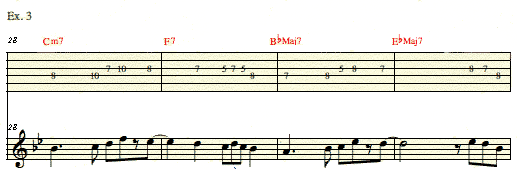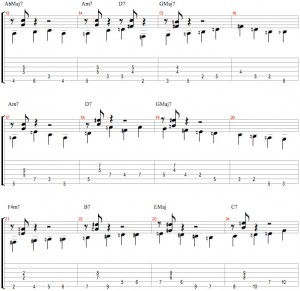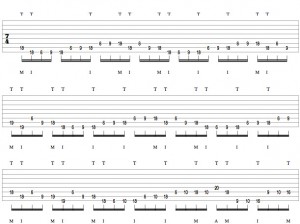| [flashvideo file=”https://guitarmessenger.com/wp-content/uploads/2007/10/guidetones.flv” width=280 height=230 /] |
Very often, “less is more” is a good policy to adopt when playing jazz. Overplaying usually gets both players and listeners pissed off because you’re getting in the way of the other musicians, while creating cluttered, disorganized music.
This can be a hard habit to break, especially for us guitarists, who are used to being the center of attention. There are many remedies that can help overcome overplaying, and the use of guide tones, which we will discuss in this lesson, is one of them.
The term “guide tones” refers to the third and seventh of a chord. These particular chord tones are the most defining in the chord, the third determining whether it is major or minor, and the seventh determining whether it is a major, minor or dominant seventh chord. Using guide tones reveals the most basic tonality of the chord and nothing more (in the realm of jazz, not the case in other styles).
Ex. 1: Defining the Chord
Example 1 shows how guide tones define a chord with Bb as the root.
Ex1

Ex.2: Comping
In a scenario when you are playing chords and want to play very minimally, guide tones are the perfect choice. Not only is the sound good for these situations, but also in many standards, the guide tones actually create lines in which one note will move one half step or one whole step, while the other remains the same. This makes guide tone lines easy to play and helpful in figuring out common and neighboring tones between chords. Example two demonstrates the use of guide tones in comping “Autumn Leaves” over a bass line.
Ex2






Ex. 3: Soloing
If you’ve ever looked at a chart for a standard and said to yourself “Look at all these chords, how am I supposed to play a solo over all these changes?” guide tones can help you overcome this problem. If you know which scales to use and what the guide tones are, you can combine both to make a logical, melodic solo. Example 3 is a one chorus solo over “Autumn Leaves”. Also, if you look at the melody to this tune, you’ll see that it also targets guide tones, a prime example of their defining role in jazz.
Ex3























